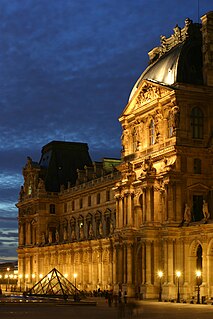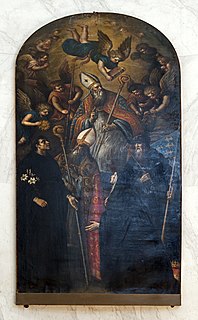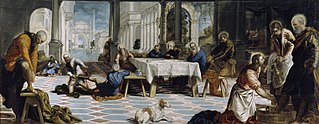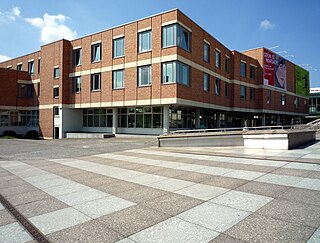Related Research Articles

An art museum or art gallery is a building or space for the display of art, usually from the museum's own collection. It might be in public or private ownership and may be accessible to all or have restrictions in place. Although primarily concerned with visual art, art galleries are often used as a venue for other cultural exchanges and artistic activities, such as performance arts, music concerts, or poetry readings. Art museums also frequently host themed temporary exhibitions which often include items on loan from other collections.

Gentile Bellini was an Italian painter of the school of Venice. He came from Venice's leading family of painters, and at least in the early part of his career was more highly regarded than his younger brother Giovanni Bellini, the reverse of the case today. From 1474 he was the official portrait artist for the Doges of Venice, and as well as his portraits he painted a number of very large subjects with multitudes of figures, especially for the Scuole Grandi of Venice, wealthy confraternities that were very important in Venetian patrician social life.

Paolo Caliari, known as Paolo Veronese, was an Italian Renaissance painter based in Venice, known for extremely large history paintings of religion and mythology, such as The Wedding at Cana (1563) and The Feast in the House of Levi (1573). Included with Titian, a generation older, and Tintoretto, a decade senior, Veronese is one of the "great trio that dominated Venetian painting of the cinquecento" and the Late Renaissance in the 16th century. Known as a supreme colorist, and after an early period with Mannerism, Paolo Veronese developed a naturalist style of painting, influenced by Titian.

National Museum Cardiff is a museum and art gallery in Cardiff, Wales. The museum is part of the wider network of Amgueddfa Cymru – National Museum Wales. Entry is kept free by a grant from the Welsh Government; however, they do ask for donations throughout the museum.

The National Museum of Art of Romania is located in the Royal Palace in Revolution Square, central Bucharest. It features collections of medieval and modern Romanian art, as well as the international collection assembled by the Romanian royal family.

The Gemäldegalerie is an art museum in Berlin, Germany, and the museum where the main selection of paintings belonging to the Berlin State Museums is displayed. It holds one of the world's leading collections of European paintings from the 13th to the 18th centuries. Its collection includes masterpieces from such artists as Albrecht Dürer, Lucas Cranach, Hans Holbein, Rogier van der Weyden, Jan van Eyck, Raphael, Botticelli, Titian, Caravaggio, Giambattista Pittoni, Peter Paul Rubens, David Teniers the Younger, Rembrandt, Johannes Vermeer, and Antonio Viviani. It was first opened in 1830, and the current building was completed in 1998. It is located in the Kulturforum museum district west of Potsdamer Platz.

The Museum of Fine Arts is a museum in Heroes' Square, Budapest, Hungary, facing the Palace of Art.

Cartwright Hall is the civic art gallery in Bradford, West Yorkshire, England, situated about a mile from the city centre in the Manningham district. It was built on the former site of Manningham Hall using a gift of £40,000 donated by Samuel Lister and it is named after Edmund Cartwright. The gallery which opened in 1904 initially had a display of artworks loaned from other galleries and private collections until it was able to purchase a permanent collection of Victorian and Edwardian works using money raised by the 1904 Bradford Exhibition.

The Crocker Art Museum, formerly the E. B. Crocker Art Gallery, founded in 1885, is the oldest art museum west of the Mississippi River. Located in Sacramento, California, the Museum holds one of the state's premier collections of Californian art. The museum contains American works dating from the Gold Rush to the present, European paintings and master drawings, one of the largest international ceramics collections in the U.S., and collections of Asian, African, and Oceanic art.

The Art Institute of Chicago, founded in 1879 and located in Chicago's Grant Park, is one of the oldest and largest art museums in the United States. Recognized for its curatorial efforts and popularity among visitors, the museum hosts approximately 1.5 million people annually. Its collection, stewarded by 11 curatorial departments, is encyclopedic, and includes iconic works such as Georges Seurat's A Sunday on La Grande Jatte, Pablo Picasso's The Old Guitarist, Edward Hopper's Nighthawks, and Grant Wood's American Gothic. Its permanent collection of nearly 300,000 works of art is augmented by more than 30 special exhibitions mounted yearly that illuminate aspects of the collection and present cutting-edge curatorial and scientific research.

Leandro Bassano, also called Leandro dal Ponte, was an Italian artist from Bassano del Grappa who was awarded a knighthood by the Doge of Venice. He was the younger brother of artist Francesco Bassano the Younger and third son of artist Jacopo Bassano. Their father took his surname from their town of Bassano del Grappa, and trained his sons as painters.
Claudio Bravo Camus was a Chilean hyperrealist painter. He was greatly influenced by Renaissance and Baroque artists, as well as Surrealist painters such as Salvador Dalí. He lived and worked in Tangier, Morocco, beginning in 1972. Bravo also lived in Chile, New York and Spain. He was known mainly for his paintings of still lifes, portraits and packages, but he had also done drawings, lithographs, engraving and figural bronze sculptures. Bravo painted many prominent figures in society, including caudillo Franco of Spain, President Ferdinand Marcos and First Lady Imelda Marcos of the Philippines and Malcolm Forbes.

Marietta Robusti was a Venetian painter of the Renaissance period. She was the daughter of Tintoretto and is sometimes referred to as Tintoretta.

The National Gallery of Armenia is the largest art museum in Armenia. Located on Yerevan's Republic Square, the museum has one of the most prominent locations in the Armenian capital. The NGA houses significant collections of Russian and Western European art, and the world's largest collection of Armenian art. The museum had 65,000 visitors in 2005.

Christ Washing the Disciples' Feet was a favourite theme of Tintoretto, and there are at least six known works by him on the subject. The scene comes from a passage in John 13 where before the Last Supper Christ washes the feet of his disciples. This passage called for a complex image with many characters in a variety of poses and motions, and the diversity and challenge attracted Tintoretto. The paintings were commissioned for various churches of Venice, though since then four of the six have left Italy.

The Kupferstichkabinett, or Museum of Prints and Drawings, is a prints museum in Berlin, Germany. It is part of the Berlin State Museums, and is located in the Kulturforum on Potsdamer Platz. It is the largest museum of graphic art in Germany, with more than 500,000 prints and around 110,000 individual works on paper.
The Pinacoteca Civica Padre Pietro Tacchi Venturi is the civic art gallery of the town of San Severino Marche, region of Marche, Italy. Located at Via Salimbeni 39, it mainly displays sacred paintings from prior centuries.
Villa Colloredo Mels is a suburban palace located on Via Gregorio XII, on the western edge of the urban center of Recanati, province of Macerata, Marche, Italy. It presently houses the civic archeologic and art museum of the town.
The Museo Civico di Mondavio is a public museum and art gallery (pinacoteca) located on Piazza Matteotti 3, where it is housed in the medieval former Franciscan monastery in the town center of Mondavio, in the Province of Pesaro e Urbino in the Italian region Marche.
References
Coordinates: 43°38′57″N13°02′52″E / 43.6491°N 13.0477°E
| This article about an Italian building or structure is a stub. You can help Wikipedia by expanding it. |